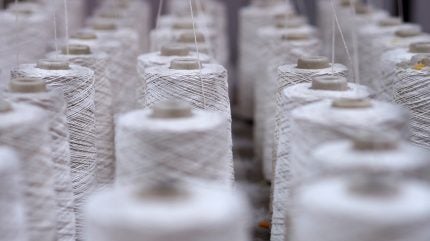
Textile Exchange’s RMDF confirms the origin of materials certified by the Global Recycle Standard (GRS) and Recycled Claim Standard (RCS).
The updated RMDF, which was launched this month, is designed to gather, standardise, and categorise information on both textile and non-textile waste.

Discover B2B Marketing That Performs
Combine business intelligence and editorial excellence to reach engaged professionals across 36 leading media platforms.
This enhancement facilitates more accurate tracking and information sharing throughout the recycling value chain.
The revamped form records standardised data points such as the composition, colour, origin, or source of fibres. It also sets the stage for future digital advancements and scalable approaches to managing textile waste.
With the data from the new form, brands will be able to determine if their feedstock is derived from recycled bottles or textiles. This increased clarity will enable brands to augment the use of recycled textiles in their products.
Knowing the source of recycled materials will enable brands to make substantiated claims about their products, leading to heightened transparency within the industry, said the company.

US Tariffs are shifting - will you react or anticipate?
Don’t let policy changes catch you off guard. Stay proactive with real-time data and expert analysis.
By GlobalDataThe update stems from a multistakeholder project initiated by Textile Exchange and Fashion for Good in collaboration with brand partners such as adidas, Target, BESTSELLER, Norrøna, and Levi Strauss in 2023.
The project gained support from organisations including Control Union, Reverse Resources, Recover, and Usha Yarns.
According to Textile Exchange, the textile industry currently faces a challenge in pinpointing the exact origins of its recycled fibres, with uncertainty over whether they are derived from plastic bottles or other sources.
The sector also struggles with inefficient classification and standardisation of collected data.
The project’s objective was to align data collection and system functionalities, creating uniform practices for gathering and disseminating textile waste information throughout the supply chain. This includes entities such as collectors, recyclers, and certification agencies.
Additionally, the initiative examined potential collaborations with digital platforms like Reverse Resources to streamline data entry and minimise redundant efforts.
Such partnerships are steps toward establishing a fully digitalised, interoperable traceability system for the industry, said the company.
A key insight from the project was that the RMDF could be adapted to systematically capture data that enhances traceability.
Additionally, it was found that the RMDF could integrate with other systems used by recyclers. This means recyclers won’t have to duplicate their input of recycling data across different systems but can link their existing systems with Trackit, easing the traceability workload for recyclers.
At present, adoption of the new RMDF is voluntary. The first certified entities in the recycled supply chain may opt to use it when documenting their reclaimed material information.
Eventually, the RMDF will be integrated into Textile Exchange’s Trackit system, which will simplify the verification process for companies making product claims.





